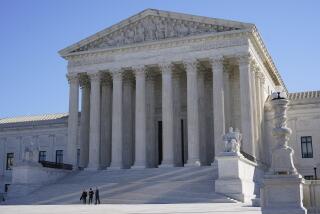Time Runs Out for Roe : The Courts are Only a Formality; for Many Women Choice is no Longer an Option
- Share via
Roe vs. Wade is dead. Whether the Supreme Court finally overrules it--this year or next--is a formality, the signing of a coroner’s certificate. Roe will not be lost in the courts, because it has already been lost on the streets.
In much of America, there is no right to abortion. In 83% of all counties, there are no clinics or hospitals willing to perform an abortion. Second-trimester abortions--even when the mother is seriously ill, or the fetus will not survive--are still harder to come by. There’s one place in Southern California that I’ve heard of, and one in Boulder, Colo.--but neither has a sign on the door, and they certainly don’t invite publicity.
The only doctor who performs abortions in South Dakota works in a cinder-block office, protected by alarms and bulletproof windows. The only doctor who performs abortions in North Dakota lives in Minnesota. The number of hospitals offering abortions dropped 50% from 1977 to 1988, while only 13% of the nation’s residency programs now train young doctors to perform first-trimester abortions.
Meanwhile, the justices of the U.S. Supreme Court deliberate on yet another abortion case--which will, no doubt, curtail access to abortion even more, while paying lip service to the tattered remnants of Roe vs. Wade. After all, this is an election year.
Judges and politicians have certainly played an important role in stripping American women of their right to privacy. Courts have upheld restrictions on the use of public funds and public hospitals, effectively blocking access for poor women. As far back as 1979, they upheld restrictions on the rights of minors to have abortions. They also tolerated a variety of consent rules and record-keeping requirements that increase the cost of abortions, albeit fewer than those Pennsylvania will almost certainly be permitted to impose by the Supreme Court.
The tactic of making access most difficult for women with the least power--the young, the poor, women who don’t have private physicians willing to help--has been politically and judicially encouraged. If middle-class women had lost their rights first, it would be another story.
But at least laws are passed by democratically elected majorities. What is most pernicious about the loss of abortion rights in this country is the extent to which it has been a triumph of a small minority--elected to no office, appointed to no court--practicing the politics of coercion, with a wink and a nod from those who should know better.
Doctors have a right not to perform abortions, if doing so would violate their own moral precepts. But there is no evidence that the medical profession woke up one day and decided, en mass, not to perform abortions for moral reasons. The dearth of doctors is not a product of moral debate but, by all accounts, of fear. Terrorism works.
I don’t blame young doctors for refusing to perform abortions--I’m not sure I’d have the courage to face the threats and pickets, let alone expose my family to them. But you shouldn’t have to be a hero to be a gynecologist.
Last summer, when the anti-abortion extremist group Operation Rescue moved into Wichita, Kan., a courageous federal judge say his job as protecting the constitutional rights of those choosing abortion. The Bush Administration disagreed. They filed briefs in court arguing that there is no basis for federal courts to protect federal rights against trespassing protesters. The case is now in the Supreme Court. Abortion-rights activists know what that means.
Last week, when Operation Rescue moved into Buffalo, N.Y., invited by that city’s mayor to violate its laws, abortion-rights activists were not relying on the courts or the politicians to keep the clinics open. They’ve formed human rings of their own, proving two sides can play this ugly game. I would hate to be a 15-year-old, pregnant rape victim in Buffalo.
But you can’t form human rings around every doctor’s office and every hospital in America. Operation Rescue is not going away. Louisiana, Idaho and Guam have already passed laws even more restrictive than Pennsylvania’s. The real question in this election year is not whether the court will formally overrule Roe vs. Wade--it will, but probably next year in the Guam case--but whether the majority in this country will use their ballots to take control back from the gangs now terrorizing doctors, frightening women and denying basic rights.
There is no question that abortion-rights activists will be focusing on this fall’s presidential election and seeking to make abortion a critical voting issue. Indeed, they talked of little else when the case was argued before the court on Wednesday, using the opportunity of the Supreme Court hearing to focus on politics rather than law. But issues in presidential elections are ultimately shaped not by what the candidate’s supporters say, but by what the candidates themselves say and do. It is one thing for Bill Clinton to attend a pro-choice rally in March. It is quite another for him to speak of abortion every day on the campaign trail.
Most candidates have not been comfortable enough with the abortion issue to do that. For their part, voters have not been so comfortable, either.
The abortion issue is a painful and personal one for most Americans. They are not for abortion. They are troubled by the number of abortions in this country. They want to keep the government out of the decision, because they view it as an individual, moral choice. The challenge for the abortion-rights side is to convince voters to treat this personal, moral decision as a public-policy issue that should influence their vote.
What makes the task more difficult is the question of whose ox is being gored. The abortion issue should work best for the abortion-rights side in states where there is a strong abortion-rights majority--like California, which could be the critical battleground next fall. But California women are not in immediate jeopardy, precisely because the abortion-rights sentiment is strong here. At least for now, our rights are protected, not by tattered remnants of Roe, but by the state Constitution and the state courts, and even most of our political leadership--Democratic and Republican. Will California’s abortion-rights Republicans desert George Bush because of what is happening to young women in Kansas City and Buffalo, or what will happen in Pennsylvania, Guam and Utah?
We know what the activists will do. We know what the Supreme Court will do. The question now is what the voters will do. They are the only ones who can restore the protections of Roe vs. Wade.
More to Read
Get the L.A. Times Politics newsletter
Deeply reported insights into legislation, politics and policy from Sacramento, Washington and beyond. In your inbox three times per week.
You may occasionally receive promotional content from the Los Angeles Times.










